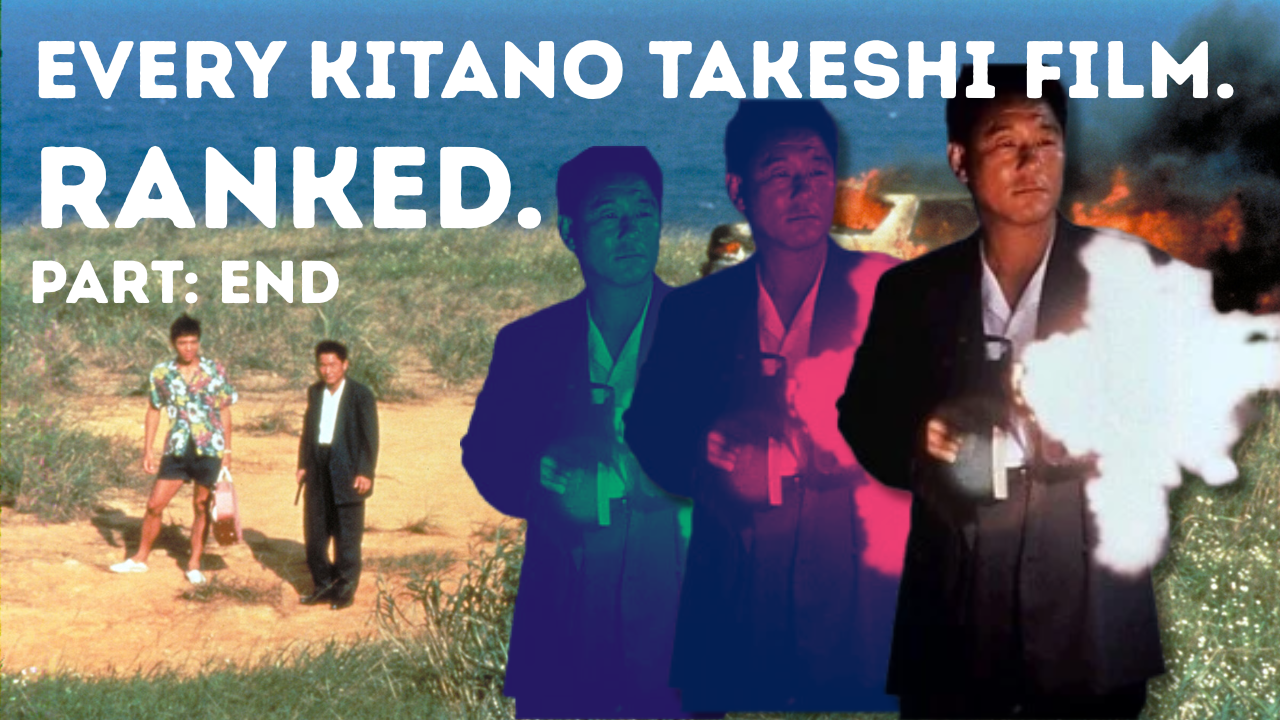All (mostly?) good things come to an end, and today, we’re finishing our three-part retrospective ranking of all 20 films of Japanese auteur Kitano Takeshi. We’ve explored 14 of his films so far, from the bad to the inexplicable to the flawed but fascinating. Today, we rank the six films we consider his very best. These are all impressive films in their own way – and some are Takeshi’s outright masterpieces.
If you’re new to this ranking, Part 1 is here, and Part 2 is here.
Table of Contents
Toggle#6: Kubi (2023)
首

Kubi is essentially Takeshi Kitano’s Ran. Bear with me here: it’s a long-gestating, late-stage samurai war epic by an aging director that, at least in terms of scale, blows anything else he’s made out of the water. It has a mostly nihilistic bent, telling us about the pointless violence of war and the degradations men are willing to mete out against those they’d previously pledged loyalty to. It’s also proof that an old directorial dog can still knock one out of the theatrical park. (How’s that for a mixed metaphor?)
Now, I’m not saying Kubi is as good as Ran; very few films are. But Kitano Takeshi’s epic on the final years of Japan’s Warring States period and the rise of the crafty peasant-born warlord Toyotomi Hideyoshi (played with comedic panache by an obviously too-old Takeshi) still has much to recommend it.

Kubi was Takeshi’s first new film in six years, following his string of yakuza-focused films in the 2010s. It’s a major step up from those more recent outings in terms of production value and, more importantly, visual flair. It also out-violences the Outrage trilogy, so well known for its graphic bloodletting. Indeed, it’s a major departure for Takeshi‘s filmography as a whole, being on such a large scale. 2003’s Zatoichi is the only comparable samurai period piece, but even then, they’re completely different: Zatoichi is a small-scale, wanderer-takes-down-local-evil-doers sort of story.
Review: In Beat Takeshi’s Kubi, Samurai are Queer Yakuza
Internationally famed director Kitano Takeshi is back with his new samurai epic, Kubi. The violent, darkly funny film has some surprises in store for viewers. Our main site: www.unseenjapan.com Follow us on Twitter: https://twitter.com/UnseenJapanSite Support Unseen Japan by becoming a Patreon patron — it’d mean the world to us: http://bit.ly/ujpatreon Original Godzilla Minus One review on our website: https://unseen-japan.com/review-godzi…
Momoyama Gangsters
In fact, there’s more of a connection to Takeshi’s non-samurai films here. In some ways, Kubi is like a feudal transplant of the Outrage series. And just like the Outrage series, much of this movie is a series of exposition-filled meetings between a vast array of combatants on various sides with names you’ll quickly forget, scheming against each other. Here, the film relies on you being familiar with these famed Warring States period figures, which at least makes the movie a little easier to follow for those in the historical know. If you’re not, keep your finger hovering over the pause button and another over the new tab hotkey – you’ll want Wikipedia on digital speed dial.
I wrote about this in my review for the film during its theatrical run, but the other big connection to Takeshi’s filmography is in how he presents the samurai. They’re played almost exactly as yakuza, including regional accents, slurred speech, and motivation. Feudalism is often compared to the mafia these days, so it’s a fitting, and interesting, take. Still, the yakuza-style acting can be a bit much. In particular, Kase Ryo as Nobunaga and Endo Kenichi as Araki Murashige are a bit overdrawn.
We also have Nakamura Shidō II playing a Smeagol-like peasant character attempting to find his fortune by joining up with a samurai army; sadly, this is another overblown depiction. He echoes similar characters from the likes of Kurosawa’s The Hidden Fortress, Mizoguchi’s Ugetsu, and Inagaki’s Musashi series, but lacks the same charm or depth. Rather than being portrayed as in any way aspirational, the character instead echoes the yakuza recruitment structure; he’s an underprivileged and dimwitted punk trying to join up with an organization to claim his fortune by way of violence. While I find this character to be a low point for the film, Takeshi is still trying to do something interesting here.
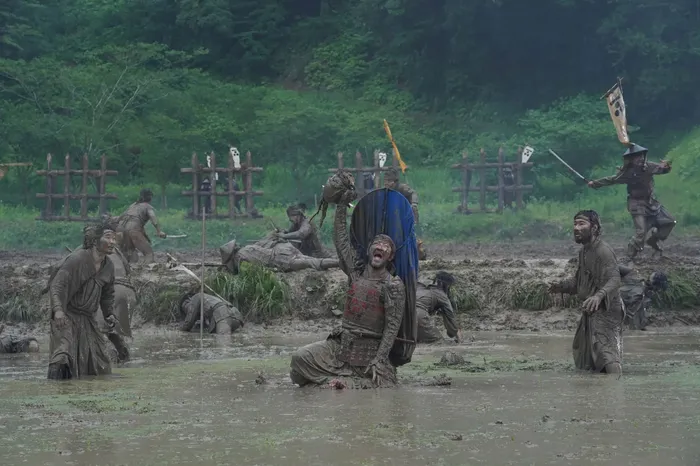
Warriors, Come Out to Play
Conversely, a fun inclusion is Kimura Yuichi as Sorori Shinzaemom, a famous Warring States-era comedian in Toyotomi’s employ (as a ninja, in this case). The character allows Takeshi to tie his comedy roots back more than 500 years in Japanese history. He’s also joined by longtime Takeshi regular Susumu Terajima as a ninja compatriot.
Kubi is such a large-scale film that there’s much more we could discuss; it’s a compelling time in feudal (or is it futile?) Japan, with numerous asides and even a few hints of Takeshi’s comedy routines. It feels like Takeshi is trying to get the most out of his chance to make a movie on this scale. Kubi unexpectedly emerges as one of his more darkly funny films.
All the film’s lesser and somewhat annoying qualities are front-loaded, and by the time the credits roll, Takeshi has provided us with an epic that only he could have made. Despite spiritual similarities to the Outrage series, Kubi has a much greater scope, and greater rewards. For such an ambitious late-period film, you can only be pleased it came to fruition.
#5: Ryuzo and the Seven Henchmen (2015)
龍三と七人の子分たち
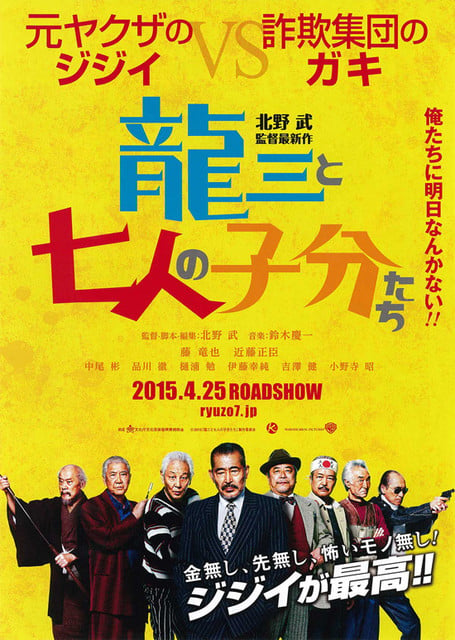
Ryuzo and the Seven Henchmen, a comedic interlude for Takeshi in the midst of his ultraviolent Outrage yakuza trilogy, was the first Takeshi film I saw on release in theaters in Japan. I was a twenty-something English teacher in Fukushima Prefecture, and had loved every Takeshi film I’d seen – which was four films total, all from the cream of his crop. So, when I first saw Ryuzo, a jokey and somewhat meandering story about retired yakuza getting the criminal band back together, I was a bit disappointed.
Rewatching Ryuzo for the first time in a decade, however, I realize what I’d missed. This is actually a very funny (and surprisingly coherent) entry from Takeshi. It’s also a film that wears its yakuza genre and historical references on its sleeve. Back in 2015, what I knew about yakuza mostly came from Jake Adelstein’s book Tokyo Vice, the Yakuza game series, and a single interaction with a former member I’d had as a twenty-year-old. These days, covering history, current events, and media topics related to the Japanese underworld is part of my job, as both a journalist and interpreter. (Including some more up-close-and-personal experiences.) In other words, I’m picking up a lot more of what Ryuzo is laying down.
The set-up here is pretty genius. A retired yakuza soldier, whose civilian son is embarrassed by his father’s criminal past, falls for the notorious “ore ore” phone scam. The perpetrators are part of the post-yakuza criminal underground, no longer bound by any of the yakuza’s codes of conduct. Ryuzu, part of a (literally) drying breed of honor-bound, tattooed gangsters, decides to reform his old gang. He collects seven of his surviving buddies, each with their own humorous back stories and degrading skill sets. These often reference yakuza tropes: the 70s Suzuki Seijin-style gunfighter, the hard-right Imperial Way nationalist, the sword-wielding late-stage samurai type. There’s even a guy who throws nails with deadly accuracy. (A more mortal Blue Raja, essentially.)
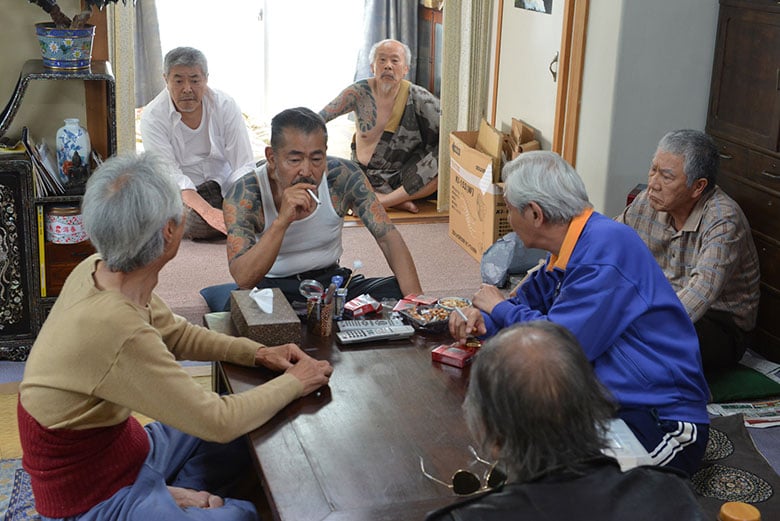
These Old Tattoos Don’t Run
The film sets up a showdown between the (very) old-school yakuza and the modern non-affiliated scammers. The pathway the film takes to reach this clash is a bit circuitous; like many Takeshi films, the framing is basically an excuse for a series of gags. But unlike so many of Takeshi’s straight comedy films, the structure still holds. In other words, this feels like a real movie, rather than a jumble of unrelated sketches. This is because the humor stays on point: it derives from a consistent theme, being over-the-hill gangsters clashing with the modern world around them.
Given the theme of age, Takeshi wisely extricates himself from the action; instead, he appears a few times as a cop. The main roles go to more expressive actors, with Fuji Tatsuya putting in a charismatic and funny turn as the titular Ryuzo. You can see bits of Takeshi’s usual yakuza protagonists filter into Ryuzo, but Fuji brings a bit more charm (and is less monosyllabic). The entire cast is great, and age-appropriate: the average age for the film was 72.
In its own strange way, Ryuzo feels like Takeshi’s most true-to-life yakuza film. It’s enjoyably silly, but it reflects the yakuza’s true downturn since the 2011 anti-yakuza laws kneecapped their criminal way of life. Meanwhile, in the contemporaneous Outrage series, Takeshi was presenting an imagined, powerful Japanese underworld as it hadn’t been in a decade or more. Ryuzo pays tribute to the media traditions of the yakuza genre, while referencing real-world events. (Including such deep pulls as the time someone tried to assassinate yakuza fixer Kodama Yoshio by flying a byplane into his house.)
I had a little viewing party for this one, with my wife, Jake, and some friends in attendance. I’d remembered the film as a bit dull, but to my surprise, we were laughing all the while. Ryuzo, it turns out, is the sort of movie that’s worth watching and showing to others. In other words, it’s by far the best of Takeshi’s full-blown comedy films.
#4: Kikujiro (1999)
菊次郎の夏
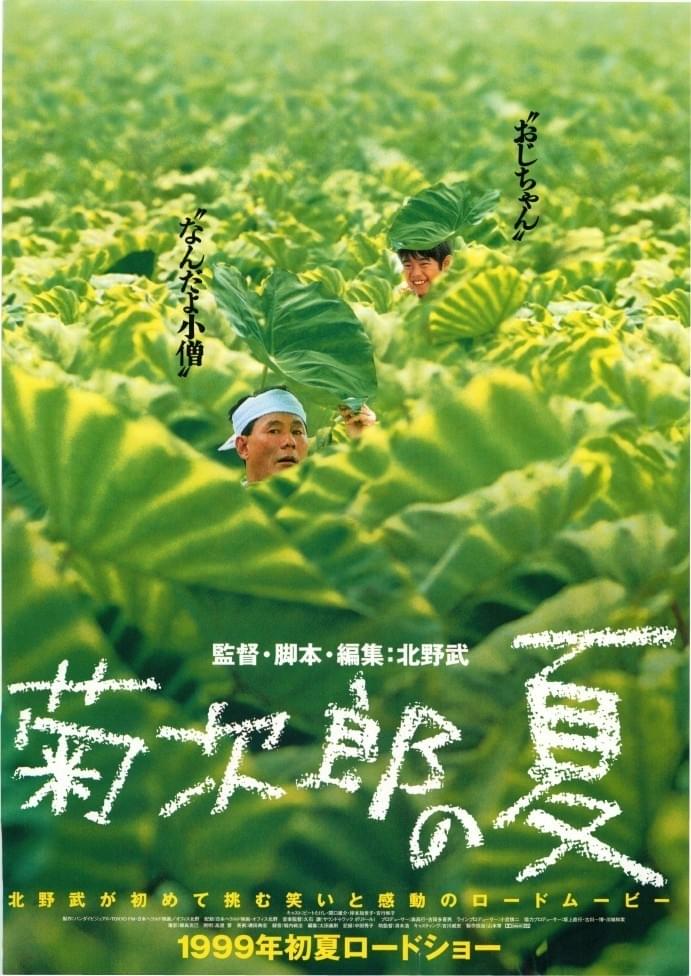
With this film, we’re now amongst what many recognize as the four best movies Kitano Takeshi ever made. There’s a reason these four tend to gather such high esteem; we start off with a movie that’s both very Takeshi, and yet very unique in his filmography.
Planning a trip to Japan? Get an authentic, interpreted experience from Unseen Japan Tours and see a side of the country others miss!

"Noah [at Unseen Japan] put together an itinerary that didn’t lock us in and we could travel at our own pace. In Tokyo, he guided us personally on a walking tour. Overall, he made our Japan trip an experience not to forget." - Kate and Simon S., Australia

See a side of Tokyo that other tourists can't. Book a tour with Unseen Japan Tours - we'll tailor your trip to your interests and guide you through experiences usually closed off to non-Japanese speakers.


Want more news and views from Japan? Donate $5/month ($60 one-time donation) to the Unseen Japan Journalism Fund to join Unseen Japan Insider. You'll get our Insider newsletter with more news and deep dives, a chance to get your burning Japan questions answered, and a voice in our future editorial direction.
The plot: Masao is a quiet young boy living with his grandmother in the environs of the old Tokyo neighborhood of Asakusa; his father has passed away and his mother is said to have left home to work. Lonesome during summer break, he decides to make a break from Tokyo and head to Toyohashi, Aichi, where he believes his absent mother now lives. Along for the ride is a local thug (the titular Kikujiro, named for Takeshi’s real-life father), the husband of a neighborhood woman who takes pity on Masao.
Beat Takeshi babysitting a monosyllabic kid might not sound like a great time. The end result, however, is a road trip as only Takeshi could imagine it. Funny, sweet, and sad, it’s one of Takeshi’s best.
The Road to Toyohashi
A note: There is one scene of attempted predation that’s mostly played for laughs that some will find disturbing, and that likely plays less well these days than 1999. It treads a thin line between Takeshi’s dark humor and tastelessness, and your mileage may vary. (It certainly plays better than Takeshi’s battered woman jokes from Boiling Point, at least.) The scene comes back to haunt Masao’s dreams, part of a series of memories imbued into his psyche during his road trip with Kikujiro.
Speaking of dreams, I’d forgotten the beautiful, surrealistic imagery that pervades sections of Kikujiro. The main story is grounded, but Masao’s dreams and occasional flights of fantasy allow for some wonderfully directed, dreamlike imagery. There’s also numerous inventive shots and camera angles. You can really feel Takeshi flexing his creativity compared to his more restrained direction in Kids Return or A Scene by the Sea. (His two other films to this point that hadn’t been mostly concerned with police or yakuza violence.)

Self-Reflection? Wish Fulfillment? Takeshi’s Search for a Father Figure
Kikujiro himself is an interesting character for Takeshi. He has many of his usual character traits. (He’s a yakuza with a small vocabulary who often bullies others, but has a wry sense of humor.) But unlike most of Takeshi’s characters, he’s nothing but a low-level thug. He’s scrappy, but when he gets in trouble with some local yakuza from a different gang (by breaking the unspoken rules of Japanese festival games – shouldn’t he know that the tekiya who run festival stalls are often yakuza themselves?), he just gets beaten up. He never gets revenge; he’s just beaten.
The second of two road films in a row, Kikujiro is a continuation of Takeshi’s consistent theme of escape. It’s also the best combination of Takeshi’s humor with a more gentle story. Kikujiro is among his funniest movies, in fact – Even if Takeshi’s character, as usual, is a little bit of a sociopath. (Something I noticed more on this viewing than before.) But his slowly developing paternal relationship with Masao, in whom he clearly starts to see a little of himself, has a warmth rarely seen in his filmography.
If Kikujiro doesn’t quite hit the highs of the following three films, it may be because the film feels a little overlong. It’s a bit flabby in the middle, as Kikujiro and Masao attempt and fail to hitchhike for a few too many scenes in a row. But it still has some real emotion and surprisingly impactful moments. It’s about the ways adults can impact children by their presence or absence – how positively a little creativity and kindness can affect a child, or how negatively absenteeism can hurt them. This theme holds true for both principal characters.
More than its main themes, though, the movie is also an exploration of the joys of childlike imagination, both in children’s way of perceiving the world, and in how adults utilize creativity to associate with children. It’s got some great life lessons – although maybe don’t mimic Kikujiro too much. Rampant theft, willful acts of endangerment, threats of violence, actual violence; kind or not, Kikujiro lives up to the yakuza tattoos on his back.
#3: Zatoichi (2003)
座頭市

In 2003, Takeshi made his most surprising film to date: one that was a hit at the Japanese box office. This was Zatoichi, Takeshi’s take on the long-running, then-dormant film series about a blind masseuse in Tokugawa-era Japan ,who wanders into town and strikes down evil with the sword hidden in his cane. Sporting a shock of blond hair, Takeshi’s Zatoichi likely surprised even himself. This was his first real “director for hire” gig, although he still wrote, directed, and edited it himself. The violent samurai period piece went on to make $28 million at the Japanese box office, and to take home the Silver Lion for Best Director award at the Venice Film Festival. For the only time, foreign praise and domestic notoriety went hand in hand for a Kitano Takeshi joint.
Takeshi explained his initial doubts about the project in an interview with the AV Club:
“Frankly speaking, I wasn’t a big fan of Zatoichi. He is such a preposterous character. ‘An affable blind-masseur-cum-masterful-swordsman with a lightning stroke and dead-on precision. By the way, he’s also a gambling genius.’ Impossible! In TV shows, I have often made fun of the character. I played blind and continuously made visual gags. In my film Getting Any?, I made a sketch on this character. At that time, I never dreamed I would end up making this film. When the project was proposed, I said at first that it wouldn’t be possible, because I had made fun of the character too much. But I was assured that the TV shows had already been forgotten, so I ended up accepting. I’m still a little embarrassed.” [1]
It All Comes Down to Blind Luck… Or Does It?
It’s fun to think about how such an unlikely film emerged as one of Takeshi’s best. Despite Takeshi’s remarks on this being a work-for-hire job, it has many of his trademarks. There’s his wry, observational sense of humor (and occasional silly pratfall) and directorial creativity. The movie also feels properly energetic, as if the change of setting and genre has allowed Takeshi to stretch his talent a bit more than he’d recently been able to. Some of that energy may come from Takeshi actually moving his camera; a major departure from his poetic static long-shots. Takeshi explained his rationale for this major change:
“I feel I was more of an artisan rather than an artist, hired to create commercial films with the intention of pleasing those people. So I followed the so-called shooting style for commercial films, dividing scenes with more shots, moving cameras with cranes and railings. Despite those constraints, I really enjoyed making this movie, and I found it easier to direct than my own arthouse pieces.” [1]
The film isn’t perfect, though. The digital blood effects leave something to be desired; they’re only a slight step up from the pink CGI Klingon blood in 1991’s Star Trek VI: The Undiscovered Country. Musically, it’s also a step down from Hisaishi Joe’s scores for Takeshi. The primary music feels a bit cheaper (if still very Takeshi), although the way non-diegetic sound mixes with in-scene action is a cool directorial touch. This is Takeshi’s first collaboration with composer Suzuki Keiichi, perhaps best known for his contributions to the wonderful soundtracks for the Earthbound/Mother series of video games. (Here on UJ, he’s likely most recognizable for his score for Kon Satoshi’s excellent Christmas film Tokyo Godfathers.)
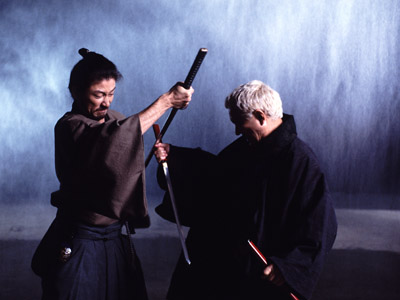
Massage on Message
Takeshi’s version of the blind masseuse is a perfect role for the actor. It allows him to play someone properly different from his usual taciturn yakuza-and-or-cop, yet still meshes with his often understated, monosyllabic acting style. Some of Takeshi’s roles can feel a bit depressed or underwritten, but his Zatoichi feels like he’s listening intently to the world around him – his silence feels tactical. Takeshi also imbues the character with some of his classic humor without going over the top. It’s a shock that he never returned to the character, given how good he is as Zatoichi.
Chambara (sword-fight) films tend to be filled with stock characters. Takeshi takes the cast here a bit further, making our primary characters all interesting, if not incredibly deep. Of special interest are a pair of sympathetic highwayman geisha, a sister-brother pair whose parents were murdered ten years previous. The brother is an onnagata, dressing and acting as a female geisha; as he would do later in Kubi, Takeshi seems interested in the blurry lines of gender in samurai-era Japan. He also gives Zatoichi’s main foil, a skilled ronin played by legendary Asano Tadanobu (Scoresese’s Silence, Shogun) just enough of a backstory to make their confrontation interesting.
Takeshi has spoken of how he considers Zatoichi the real villain of the film. Zatoichi wanders into town, and his willingness to dole out violence against the morally depraved turns a post town, initially filled with simmering gang violence, into a full-on bloodbath. That’s an interesting perspective, but it can’t be denied how enjoyable it is to watch Zatoichi dispense his justice on hordes of yakuza and hired thugs.
There is a bit of an issue that I think might be a natural outcome of the Zatoichi formula: Zatoichi wanders into town, meets suffering townsfolk, and takes down the bad guys. This means that Zatoichi is actually the least motivated character in the film, and that the characters with the most cause for action end up with less agency. But enjoying this sort of film means reveling in the power/justice fantasy; and, in this sole case, seeing Takeshi actually playing a heroic, selfless character.
This makes Zatoichi perhaps Takeshi’s most purely enjoyable film. It’s certainly his most approachable. It’s at the opposite end from his highly personal, idiosyncratic fare – and honestly, that’s not a bad thing. I’m sure I’m not alone in wishing he’d made a few more like Zatoichi.
#2: HANA-BI/Fireworks (1997)
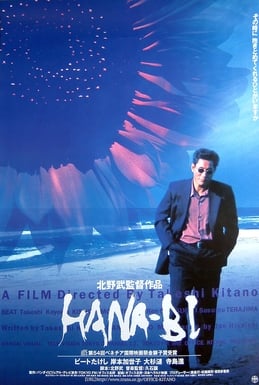
And, at long last, we come to Kitano Takeshi’s two undisputed masterpieces.
In this film, Beat Takeshi plays a silent cop with a violent temper boiling underneath; does it feel like I’ve been repeating myself? It’s fitting, though, because Hana-bi is like the grown-up version of Takeshi’s freshman outing, Violent Cop. In it, Kitano Takeshi is Detective Nishi, thrown off the force after a deadly encounter with a criminal. His daughter has passed away, and his wife is slowly dying of cancer. Nishi has the yakuza on his back over loans he took out to pay for his wife’s treatment. He’s at the end of the road, or, so it seems, until he hits the road on a cross-country car trip with his wife.
Planning a trip to Japan? Get an authentic, interpreted experience from Unseen Japan Tours and see a side of the country others miss!

"Noah [at Unseen Japan] put together an itinerary that didn’t lock us in and we could travel at our own pace. In Tokyo, he guided us personally on a walking tour. Overall, he made our Japan trip an experience not to forget." - Kate and Simon S., Australia

See a side of Tokyo that other tourists can't. Book a tour with Unseen Japan Tours - we'll tailor your trip to your interests and guide you through experiences usually closed off to non-Japanese speakers.


Want more news and views from Japan? Donate $5/month ($60 one-time donation) to the Unseen Japan Journalism Fund to join Unseen Japan Insider. You'll get our Insider newsletter with more news and deep dives, a chance to get your burning Japan questions answered, and a voice in our future editorial direction.
Hana-bi (stylized as HANA-BI and originally released in America under the translated title “Fireworks”) is an obvious choice for any Takeshi ranking best-of-class. It’s the film that fully brought Takeshi to the attention of overseas cinephiles and tastemakers. When it played in competition at the 54th Venice International Film Festival, it did something incredible – it took home the Golden Lion. Takeshi himself has relaid just how much that changed his films’ prospects back home in Japan:
“The moment I won the Golden Lion for Fireworks at the Venice Film Festival, everything changed. The comedian who occasionally made films as a part-time job had turned into a “world-famous cinema maestro” almost overnight. It only proves how the Japanese are obsessively sensitive to the reaction of foreign countries.” [1]

Nothing to Lose; for the Audience, Everything to Gain
Perhaps Hana-bi remains Takeshi’s most famous film because it’s his easiest to take seriously. It’s the most grounded – it lacks the surrealism that so animates parts of his other masterpiece, below. It’s a Takeshi film through and through (the slow pace and sudden violence make that clear), but the story itself is surprisingly straightforward. Takeshi is stylish and aloof – this is the serious Takeshi that many foreign observers think is his natural state.
What Hana-bi also has that many of Takeshi’s films lack is true emotionality. It’s not just about nihilism or the elegiac beauty of normal life. It’s about love at the end of a road filled with tragedy, but a love that endures nonetheless. There’s really nothing else like it in Takeshi’s filmography. How many of his films are as likely to strike as deftly at your heartstrings as Detective Nishi does at the eyeballs of thuggish yakuza?
Hana-bi is a film about a laconic man, for whom everything is coming to an end – his family, his work, his usefulness. His friends are dead or off the force. His wife is terminal. And yet, in his own quiet – and sometimes violent – way, he’s trying to do his best to help the people he most cares about.

Takeshi and Hisaishi: Still a Duo Made in Filmic Heaven
Fittingly, Hana-bi’s score is one of Hisaishi’s most wistful, and, indeed, notable. It’s melancholic, but often with a tinge of forward motion. Hisaishi expertly matches Detective Nishi’s drive to right what few wrongs he can.
This is also the first film where Takeshi’s post-accident injuries are visually apparent. His face twitches, half frozen; but in a way, this only adds to his relative stoicism. He now looks physically roughed up, matching his internal emptiness. Takeshi, incredibly, took what for many would be a career-ending injury and made it part of his screen presence.
Shots of the film are also filled with Takeshi’s own paintings. Takeshi took up painting during his convalescence following his accident; his works are striking in their color and naïve simplicity. An outsider artist on paper and on film, his painings fit the themes of this deceptively simple film.
Baby, You’re a Firework
This is certainly the most downbeat (no pun intended) of the classic-era Takeshi films. It’s an actively sad film, compared to the nihilism of Sonatine. Still, it has those great Takeshi staples: sudden bursts of humor and of explicit violence. This uniquely ties in with quiet scenes of great tenderness. There’s even a meditative quality, especially when it comes to Takeshi’s art.
Hana-bi also among his most beautiful, with its focus on floral motifs. The movie shifts from its somber tone into something more wistful and wry, as Nishi takes his wife on their final road trip. While not as surreal as Sonatine, Hana-bi shares that film’s (and Kikujiro’s) longing to return to the simple pleasures of childhood. In the midst of death, violence, and deadening tragedy, simple joys – like the fireworks of the film’s title – take on deeper meanings.
Just like fireworks, though, the beauty emerges, and then, inevitably, disappears.
The catch-copy for Hana-Bi is a fitting one. “When the time comes, will you have someone to hold you?” After watching Hana-bi, you might just want someone with whom to do just that.
This is a great film by Kitano Takeshi.
#1: Sonatine (1993)
ソナチネ

In the end, could it ever have been any other film? Hana-Bi is the only movie in Takeshi’s filmography that could possibly give Sonatine a run for its money. To my mind, they’re both unquestionably Takeshi’s masterpieces. These are the two films where all the promise of Takeshi’s filmmaking – all his idiosyncrasies, his deadpan, his poetic view of mundane life mixed with stark violence, the humor he finds in life’s foibles, his insight into the deadened souls of career criminals and the law enforcement that contend with them – they all come together into something very nearly sublime.
Violent Cop and Boiling Point were the blueprint, and Hana-Bi and Sonatine are the basic aspects of Takeshi’s unique viewpoint come to full artistic fruition. They’re the quintessential Takeshi films.
Sonatine is the story of Murakawa, the ultimate stoic Takeshi yakuza. Living a life of violence has nearly completely deadened this man; he barely bats an eye when he accidentally kills a recalcitrant shop owner by forcing him underwater for too long. And Murakawa isn’t the only yakuza who’s dead in the eyes: all the gangsters in this film move in a languid, emotionless manner, resigned to a routine present and a grisly end.
When his boss decides to send him to Okinawa on a flimsy pretense in order to get rid of him, Murakawa and some underlings go to ground at a rustic house on an idyllic Okinawan beach. Here, the film’s gang violence magically grinds to a halt, and Murakawa and his crew begin to relax, to forget about the nihilism and bloodletting. Engaged in juvenile summertime games, they begin to remember what life can actually be.
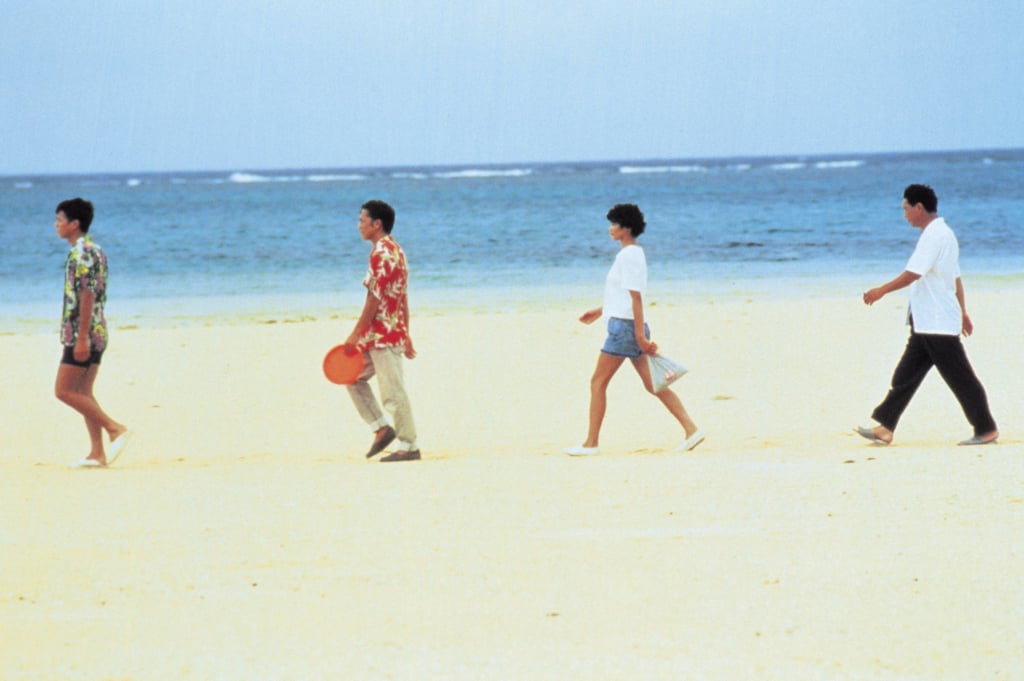
The Ultimate Idyll
The scenes at the Okinawan beach are perhaps the best in Takeshi’s entire filmography. Everything about them is pitch perfect, buoyed by one of the very best scores Hisaishi Joe ever produced. It’s synthy and elegiac and so perfectly fits the sublime surrealism of these yakuza on their beachside reverie. These scenes are playful, nostalgic, and wistful all at the same time. They somehow fill the viewer with joie de vivre alongside a sense of impending loss.
But the greatness doesn’t stop there, continuing as Sonatine begins to build towards its inevitable conclusion. The movie is filled with indelible images, contrasts of beautiful nature and gushing blood; summer rainstorms, blinding sun on white beaches, muzzle flares in the darkness, and the most famous Takeshi image of all: his rueful smile as he points a gun at his own head; is it in jest, or is his desire for final release real?
All this brings forth the rarest of experiences in a Takeshi film: actual emotion. As the yakuza come briefly back to emotional life, so too do you, the viewer. The film leaves you on an extremely impactful note, one that’s plaintive, wistful. That’s an impressive emotion to generate from a conclusion that literally ends with a bang.
Sonatine is essentially perfect from beginning to end. Watching all of Takeshi’s films has only reinforced just how much he got this one right; that there really is something special at work in Takeshi’s creative process. If his creative impulses drive him to make nigh-unwatchable films like Getting Any? or Takeshis’, that same impulse led him to Sonatine and Hana-bi, and Zatoichi, and Kikujiro. They’re all part of a continuum of Takeshi putting all of himself so clearly on his canvas. His lows are low, but his highs are very high indeed – and Sonatine sits at the very top of the creative peak of Kitano “Beat” Takeshi.
And with that, our journey through the filmography of Kitano Takeshi has come to an end. Now it’s your turn to go out and do your own watchthrough and form your own opinions on one of Japan’s most fascinating creators. But, in case you wanted to see what my tier list for his films would look like…

Sources:
[1] Phillips, Keith. (August 11, 2004.) Takeshi Kitano. The AV Club.
[2] 2007年03月22日. たけし監督13作目は漫才を映画化「バカな映画も認めるべき」. Sanspo.com. Sourced from Waybackmachine.
[3] “”Beat” Takeshi: The Hollywood Flashback Interview”. thehollywoodinterview.blogspot.com. 26 July 2008.
